Life's a Beach 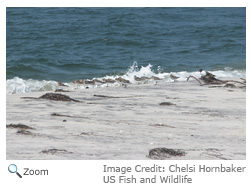 Seashores are unique areas and the organisms that live in them face many challenges. There are four types of shores. Seashores are unique areas and the organisms that live in them face many challenges. There are four types of shores.
Sandy shores are covered in sand. Sand is made up of fine grains of rock, coral and shells.
Muddy shores are covered with mud.
Rocky shores have large rocks and rocky cliffs.
Shingle shores are covered in pebbles and small rocks. All of these types of shores may have unique characteristics, but they all have one thing in common, intertidal zones.
Life in the Intertidal Zone 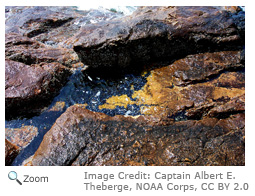 The intertidal zone or littoral zone is the area of shoreline between the high tide and low tide marks. During high tide, it is covered in water. When it is low tide it is dry or partially dry. In addition to changes in water levels, the intertidal zone can have great changes in humidity, temperature, and wave pressure during the day. The intertidal zone is rich with nutrients. As the tide comes in, it carries plankton and dead plants and animals. Animals like crabs, barnacles, starfish, anemones, shorebirds, and small fish feed on the food the waves bring in. The intertidal zone or littoral zone is the area of shoreline between the high tide and low tide marks. During high tide, it is covered in water. When it is low tide it is dry or partially dry. In addition to changes in water levels, the intertidal zone can have great changes in humidity, temperature, and wave pressure during the day. The intertidal zone is rich with nutrients. As the tide comes in, it carries plankton and dead plants and animals. Animals like crabs, barnacles, starfish, anemones, shorebirds, and small fish feed on the food the waves bring in.
Adapted for Survival 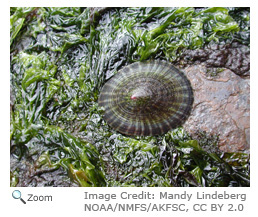 Life's not easy in the intertidal zone! Organisms there must be adapted to life in a place that is constantly changing! All of the organisms that make the intertidal zone home have adaptations that help them survive in this constantly changing environment. Arthropods and mollusks have shells that protect them from drying out and from being smashed on the rocks by waves. Organisms like limpets, starfish, and seaweed attach themselves to rocks so they don't wash out with the tides. Crabs, mollusks, sea urchins, and even bacteria often burrow under the sand when the tide is low. Life's not easy in the intertidal zone! Organisms there must be adapted to life in a place that is constantly changing! All of the organisms that make the intertidal zone home have adaptations that help them survive in this constantly changing environment. Arthropods and mollusks have shells that protect them from drying out and from being smashed on the rocks by waves. Organisms like limpets, starfish, and seaweed attach themselves to rocks so they don't wash out with the tides. Crabs, mollusks, sea urchins, and even bacteria often burrow under the sand when the tide is low.
Soup's On 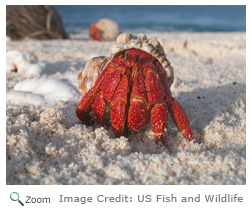 Lots of the animals that burrow under the sand when the tide is low come out to hunt for food when the tide returns. Crustaceans like the hermit crab scurry along the shore looking for food. Sea worms stick their heads out of the sand and trap food as it comes by. Mollusks like clams and mussels stick out feeding tubes or siphons and draw in food. Lots of the animals that burrow under the sand when the tide is low come out to hunt for food when the tide returns. Crustaceans like the hermit crab scurry along the shore looking for food. Sea worms stick their heads out of the sand and trap food as it comes by. Mollusks like clams and mussels stick out feeding tubes or siphons and draw in food.
|
|
Poking Around 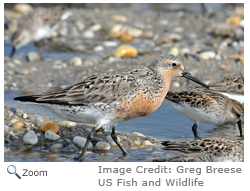 When the tide is out, the sea birds hit the beach looking for food. When the tide is out, the sea birds hit the beach looking for food.
Semipalmated sandpipers and red knots use their sharp bills to poke in the sand for worms and other invertebrates. Ring-billed gulls scour the beach searching for crabs and small fish.
Get in the Zone
The intertidal zone isn't all the same. It has four separate regions with unique features and challenges for the organisms that live in them.
Intertidal Desert 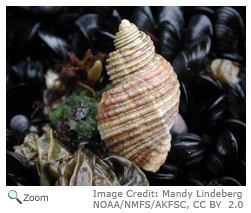 The spray zone or the supralittoral fringe is the farthest from the ocean and it is the driest zone. Usually this zone is just reached by the ocean's spray. Think of it as the desert of the intertidal zone. Barnacles, limpets, whelks, algae, and periwinkles are often be found on the rocks in this zone. Other animals like crabs and sea stars aren't as common in this area because it gets so little sea water. The spray zone or the supralittoral fringe is the farthest from the ocean and it is the driest zone. Usually this zone is just reached by the ocean's spray. Think of it as the desert of the intertidal zone. Barnacles, limpets, whelks, algae, and periwinkles are often be found on the rocks in this zone. Other animals like crabs and sea stars aren't as common in this area because it gets so little sea water.
Wash and Dry 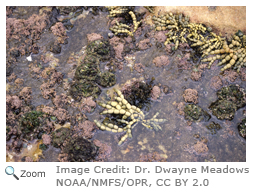 The next area is the high-tide zone or the upper midlittoral zone. It is exposed to some water during high tide when waves wash over it. Organisms that live in this zone must be able to survive in both wet and dry environments. They also must be able to survive pounding waves! Barnacles, limpets, whelks, and mussels that live in this zone attach themselves to rocks so they aren't washed away by the waves. Tidepools often form in this region when water is trapped in depressions in rocks and the sand. Some animals live in tidepools for their whole life, others wash in and out with the tides. Organisms that live in tidepools have to adjust to changes in water temperature and salt and oxygen levels during the course of a day. The next area is the high-tide zone or the upper midlittoral zone. It is exposed to some water during high tide when waves wash over it. Organisms that live in this zone must be able to survive in both wet and dry environments. They also must be able to survive pounding waves! Barnacles, limpets, whelks, and mussels that live in this zone attach themselves to rocks so they aren't washed away by the waves. Tidepools often form in this region when water is trapped in depressions in rocks and the sand. Some animals live in tidepools for their whole life, others wash in and out with the tides. Organisms that live in tidepools have to adjust to changes in water temperature and salt and oxygen levels during the course of a day.
Half and Half 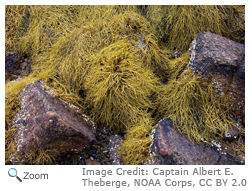 The mid-tide zone or the lower midlittoral zone is completely covered and uncovered twice a day by the tides. Plants and animals in this zone must be able to live in air and water. Animals like mussels and anemones hold in moisture by closing up when the tide goes out. Seaweeds that grow here can hold onto their moisture until the tide returns. The mid-tide zone or the lower midlittoral zone is completely covered and uncovered twice a day by the tides. Plants and animals in this zone must be able to live in air and water. Animals like mussels and anemones hold in moisture by closing up when the tide goes out. Seaweeds that grow here can hold onto their moisture until the tide returns.
Intertidal RainforestIf the spray zone is the desert of the intertidal zone, the low tide zone or intralittoral fringe is the rainforest. It is usually covered by water for most of the day. It is only exposed to air during unusually low tides. Because there is less change, life is easier for the organisms in this zone and there are more species here than in the other zones. Lots of species of seaweed, crabs, sea urchins, star fish, anemones, and small fish are common here.
|








